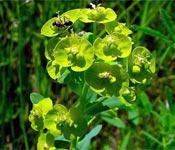Family – Spurge Euphorbiaceae
Life Cycle – creeping perennial
Habitat – reduced tillage, forage crops, hay fields, rangeland, roadsides, waste areas
Key Features
- White latex in all parts of the plant
- Deep and spreading roots with buds
- Greenish-yellow bracts underneath the flower groupings
Seedling
Cotyledons are linear in shape, pale green and veiny underneath. The seedling stem often has a few buds just above the soil surface. The first two leaves that develop appear to be opposite. Subsequent leaves are alternate, spiraling around the stem.
Juvenile
Stems are erect and hairless with sessile leaves that can be quite densely crowded. The leaves have entire margins and are linear to lanceolate. All parts of the plant cntain a white, sticky latex. Although leafy spurge does produce viable seed, propagation and spread of the plant is mainly by extensive vertical and horizontal roots with buds that can produce new shoots. The vertical part of the root system can extend very deeply into the soil profile. Leafy spurge is poisonous to most livestock, but not to sheep.
Mature
Leafy bracts are at the base of the flowering clusters located at the top of the stem and upper branches. Flowers lack petals and are found in groups of several male flowers located near one female. The pair of greenish-yellow bracts under each grouping of flowers are almost round with pointy tips. The seed capsule produced from each female flower has three compartments, each with one seed. Capsules explode at maturity, ejecting the seed a few metres from the plant. Seed color varies from yellow to grey to brown. There is also a distinct line on one side of the seed and a yellowish bump near the base.
 |
 |
 |
